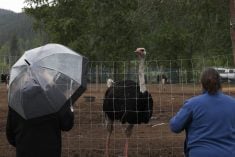The Saskatchewan government will establish four more collaborative emergency centres in rural areas to deliver better primary and emergency care to rural residents.
In this week’s speech from the throne, the government said centres will open in Shaunavon, Spiritwood, Wakaw and Canora.
The first centre opened in Maidstone in September.
“Collaborative emergency centres are open 24 hours a day, seven days a week and provide stable, predictable access for patients in rural areas,” said the speech.
In Maidstone, for example, four physicians and a nurse practitioner are on staff to provide evening and partial weekend hours.
Read Also

Russia’s top agriculture official blames low global grain prices for export slowdown
Low global prices for grains, Russia’s main agricultural commodity, have caused a sharp fall in exports in recent months.
From 8 a.m. to 8 p.m., a registered nurse and licensed practical nurse provide urgent care with the help of a doctor.
Overnight, a registered nurse and primary care paramedic are on staff to assess and treat patients. A STARS physician is available during this time for consultation.
Nova Scotia began introducing collaborative emergency centres in July 2011 and has seven of them. The province says the result is a 92 percent reduction in emergency department disruptions at the sites.
A year ago, Saskatchewan’s minister responsible for rural and remote health, Randy Weekes, toured facilities in Nova Scotia and said it was a model that Saskatchewan could use.
Other health initiatives announced include a program that will see seniors with complex health issues receive house calls from doctors, nurse practitioners and other health providers.
Officials said that about 10 percent of the seniors population account for 60 percent of all health spending on that demographic. Their multiple chronic conditions, as well as mobility issues, mean they can’t easily access primary care.
There are about 150,000 seniors in the province, and about five percent of those are in long-term care facilities. Between 6,500 and 7,000 seniors are estimated to have complex conditions.
The government will also move to combat high emergency care costs by a small number of patients.
“It is estimated that one percent of the patients using our health care system account for about one-third of all health care expenditures,” said the speech.
“In the coming year, my government will launch ‘hot spotting’ pilot programs in Saskatoon and Regina to assist high-risk, high-use patients who repeatedly show up in emergency rooms.”
Exact details have yet to be announced, but government officials said the top five users of emergency rooms accounted for more than 500 visits to emergency rooms last year. The program intends to connect these patients with more appropriate services outside the ER.















